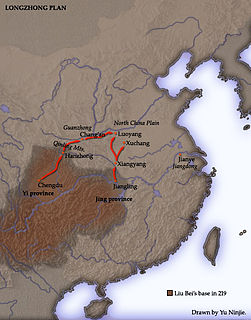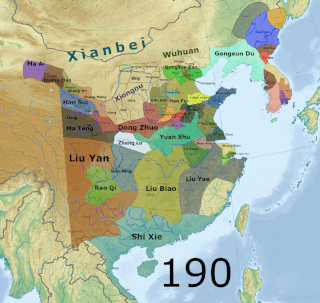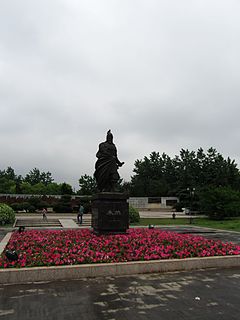The 190s decade ran from January 1, 190, to December 31, 199.
The 270s decade ran from January 1, 270, to December 31, 279.
The 210s decade ran from January 1, 210, to December 31, 219.
The 220s decade ran from January 1, 220, to December 31, 229.
The 230s decade ran from January 1, 230, to December 31, 239.
The 240s decade ran from January 1, 240, to December 31, 249.
The 250s was a decade that ran from January 1, 250, to December 31, 259.
The 260s decade ran from January 1, 260, to December 31, 269.

Year 234 (CCXXXIV) was a common year starting on Wednesday of the Julian calendar. At the time, it was known as the Year of the Consulship of Pupienus and Sulla. The denomination 234 for this year has been used since the early medieval period, when the Anno Domini calendar era became the prevalent method in Europe for naming years.

The Three Kingdoms from 220 to 280 AD was the tripartite division of China among the states of Wei, Shu, and Wu. The Three Kingdoms period started with the end of the Han dynasty and was followed by the Jin dynasty. The short-lived Yan kingdom in the Liaodong Peninsula, which lasted from 237 to 238, is sometimes considered as a "4th kingdom".
Year 190 (CXC) was a common year starting on Thursday of the Julian calendar. At the time, it was known as the Year of the Consulship of Aurelius and Sura. The denomination 190 for this year has been used since the early medieval period, when the Anno Domini calendar era became the prevalent method in Europe for naming years.

Wei (220–266), also known as Cao Wei or Former Wei, was one of the three major states that competed for supremacy over China in the Three Kingdoms period (220–280). With its capital initially located at Xuchang, and thereafter Luoyang, the state was established by Cao Pi in 220, based upon the foundations laid by his father, Cao Cao, towards the end of the Eastern Han dynasty. The name "Wei" first became associated with Cao Cao when he was named the Duke of Wei by the Eastern Han government in 213, and became the name of the state when Cao Pi proclaimed himself emperor in 220. Historians often add the prefix "Cao" to distinguish it from other Chinese states known as "Wei", such as Wei of the Warring States period and Northern Wei of the Northern and Southern dynasties. The authority of the ruling Cao family dramatically weakened in the aftermath of the deposal and execution of Cao Shuang and his siblings, the former being one of the regents for the third Wei emperor, Cao Fang, with state authority gradually falling into the hands of Sima Yi, another Wei regent, and his family, from 249 onwards. The last Wei emperors would remain largely as puppet rulers under the control of the Simas until Sima Yi's grandson, Sima Yan, forced the last Wei ruler, Cao Huan, to abdicate the throne and established the Jin dynasty.

Han, known in historiography as Shu Han or Ji Han (季漢) to disambiguate from the preceding Han dynasty, was one of the three major states that competed for supremacy over China in the Three Kingdoms period (220–280). The state was based in the area around present-day Hanzhong, Sichuan, Chongqing, Yunnan, Guizhou, and north Guangxi, an area historically referred to as "Shu" based on the name of the past ancient state of Shu, which also occupied this approximate geographical area. Its core territory also coincided with Liu Bang's Kingdom of Han, the precursor of the Han dynasty.
Lü Fan, courtesy name Ziheng, was a Chinese military general and politician serving under the warlord Sun Quan during the late Eastern Han dynasty of China. He continued serving in the state of Eastern Wu during the early Three Kingdoms period.
Jia Kui (174–228), originally named Jia Qu, courtesy name Liangdao, was a Chinese military general and politician who lived during the late Eastern Han dynasty of China. He served under the state of Cao Wei during the Three Kingdoms period.

Year 222 (CCXXII) was a common year starting on Tuesday of the Julian calendar. At the time, it was known as the Year of the Consulship of Antoninus and Severus. The denomination 222 for this year has been used since the early medieval period, when the Anno Domini calendar era became the prevalent method in Europe for naming years.

Zhu Ran, born Shi Ran, courtesy name Yifeng, was a Chinese military general of the state of Eastern Wu during the Three Kingdoms period of China. Despite being a childhood friend of Wu's founding emperor, Sun Quan, he was never given an important position or assignment before Lü Meng's invasion of southern Jing Province in 219, wherein he assisted in capturing the enemy commander, Guan Yu. Following the Battle of Xiaoting, Wu's rival state, Cao Wei, launched a three-pronged strike on Wu's northwestern, middle, and eastern borders. Zhu Ran was sent to the northwestern border, where he defended the city of Jiangling with only 5,000 troops against an enemy force about ten times greater. He rose to fame and became feared throughout Wei. He then participated in a series of military operations against Wei, during which he defeated several enemy units, but the overall objectives were never met. Before his death, Zhu Ran was granted authority to oversee matters within the army.
Wang Chang, courtesy name Wenshu (文舒), was a Chinese military general and politician of the state of Cao Wei during the Three Kingdoms period of China.

The Chu Shi Biao may refer to either of two memorials written by Zhuge Liang, the Imperial Chancellor of the state of Shu during the Three Kingdoms period of China. He presented them to Liu Shan, the second emperor of Shu. The first Chu Shi Biao, which is referred to as the "Former Chu Shi Biao", was presented in 227 before Zhuge Liang embarked on the first of a series of military campaigns against Shu's rival state, Wei. The second, known as the "Later Chu Shi Biao", was supposedly submitted in 228 before Zhuge Liang left for the second Northern Expedition.

Wang Shuang, courtesy name Ziquan, was a military officer of the state of Cao Wei during the Three Kingdoms period of China. He initially participated in battles against Wei's rival state Eastern Wu but was defeated and captured. Later, he rejoined Wei and was reassigned to the western front to fight against Wei's other rival state, Shu Han. He was killed in battle against Shu forces.






